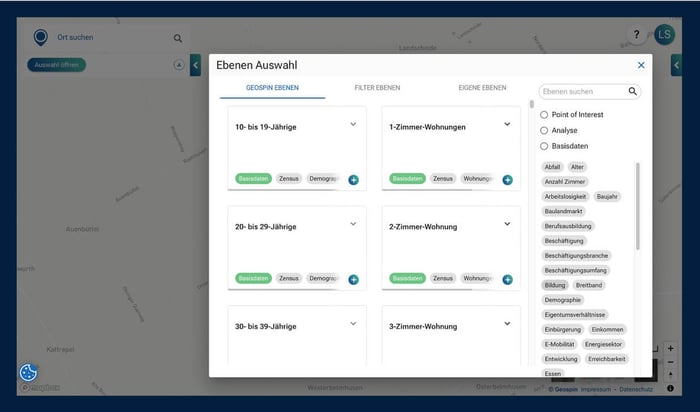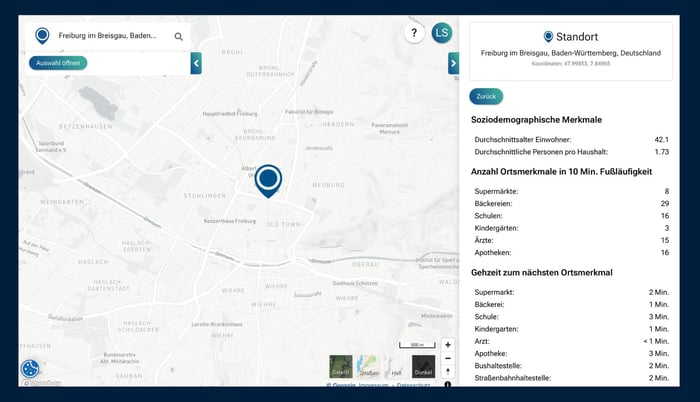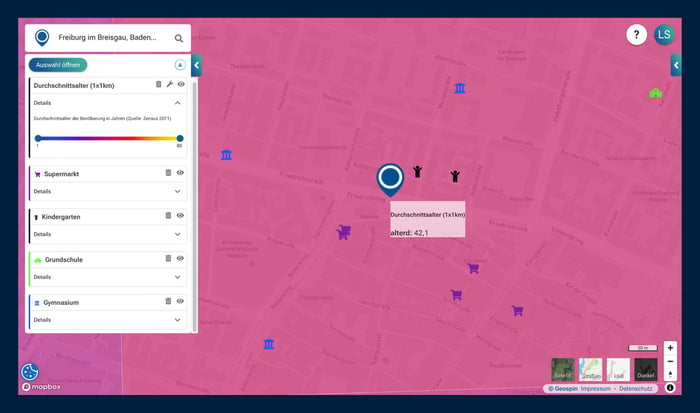The next important tool in our toolbox is site assessment. Why is site evaluation so important? And what factors play a role in it?
Site evaluation means gathering information around a given address. Both the micro and the macro location are considered here. The macro location describes the infrastructure of the city or region, whereas the micro location refers to the immediate surroundings around a location.
When considering the micro-location of a site, various aspects can play a role, such as:
- Is there a public transport connection?
- Are there facilities such as kindergartens, daycare centers and schools in the immediate vicinity?
- What is the age structure of residents?
- When were the surrounding buildings built?
- Are shopping facilities available?
- How far is the nearest recreation park?
In order to make the most accurate possible assessment of a location, large amounts of complex data must be taken into account. Economic factors such as income distribution can be considered, as well as data on the demographics of the population. Depending on the question, data on infrastructure, land use or weather data, for example, can also provide added value.

Map 1: Numerous data on a wide range of topics are available to users of our portal for their location assessment
This data must not only be collected, but also analyzed in a neutral manner. This process is very time-consuming, as many resources are needed to research and collect the data. Aggravated by the fact that the result is often inaccurate and subjective. And this is where Location Intelligence comes into play. Location Intelligence is able to analyze large amounts of information in a fraction of the time and provide forecasts. And you can find this solution in our portal.
Example: Site evaluation for building ground development
Let's take a look at location assessment using an example from the real estate industry. For a housing association that wants to develop new building land for young families, factors such as proximity to supermarkets, kindergartens and schools are important. In addition, the housing association is looking for a location with a below-average age of the residents. To assess the location of new housing units they can use our Location Intelligence Portal. They enter the desired address and can have the potential location assessed at the click of a button. On the right-hand side, you will find socio-demographic information on the average age of residents and the average number of persons per household at the selected location. In addition, the housing company will directly find the information on how many kindergartens, schools and supermarkets are within 10 minutes walking distance and what is the walking time to the nearest super market for example. After the employee of the housing association has logged in to our portal and performed the location assessment, he will find the results as shown on map 2.

Map 2: Results of the location assessment
Map 3 shows the activated data layers on average age, supermarkets, kindergartens, elementary schools and high schools. It turns out that the average age at this location is not below average, but the desired infrastructure is available. The employee of the housing association can add layers as he likes. In this way, our portal helps him to query numerous factors for his decision-making process with just a few clicks and to display them in color.

Map 3: Visualization of the selected criteria at the requested location
Let's now look at the benefits of location intelligence for the real estate industry. With Location Intelligence, accurate forecasts of property development can be made, which serve as a solid basis for investment. The location of commercial and residential properties and the significance for price development can thus be easily estimated.
The evaluation of locations is of central importance for numerous industries
In the energy industry, for example, a location assessment can be interesting for identifying suitable sites for charging stations. In this case, the location assessment could evaluate whether parking spaces, public charging points, cafes and supermarkets are nearby. As local retail competes with online shopping, it will also become increasingly important to look as closely as possible at the location of the shop. This makes it much easier to assess and predict competition and customer flows. Relevant here, for example, is the accessibility of the location. The factors that play a role in the location assessment thus depend heavily on the particular issue. Location assessment cannot do without the evaluation of numerous complex data. Location Intelligence is the solution for analyzing these data volumes as objectively as possible and in a resource-saving manner.
Let our Location Intelligence Assistant LIA show you another example of location analysis here:
Are you curious and want to test our portal yourself? Register free of charge!
-1.png)







